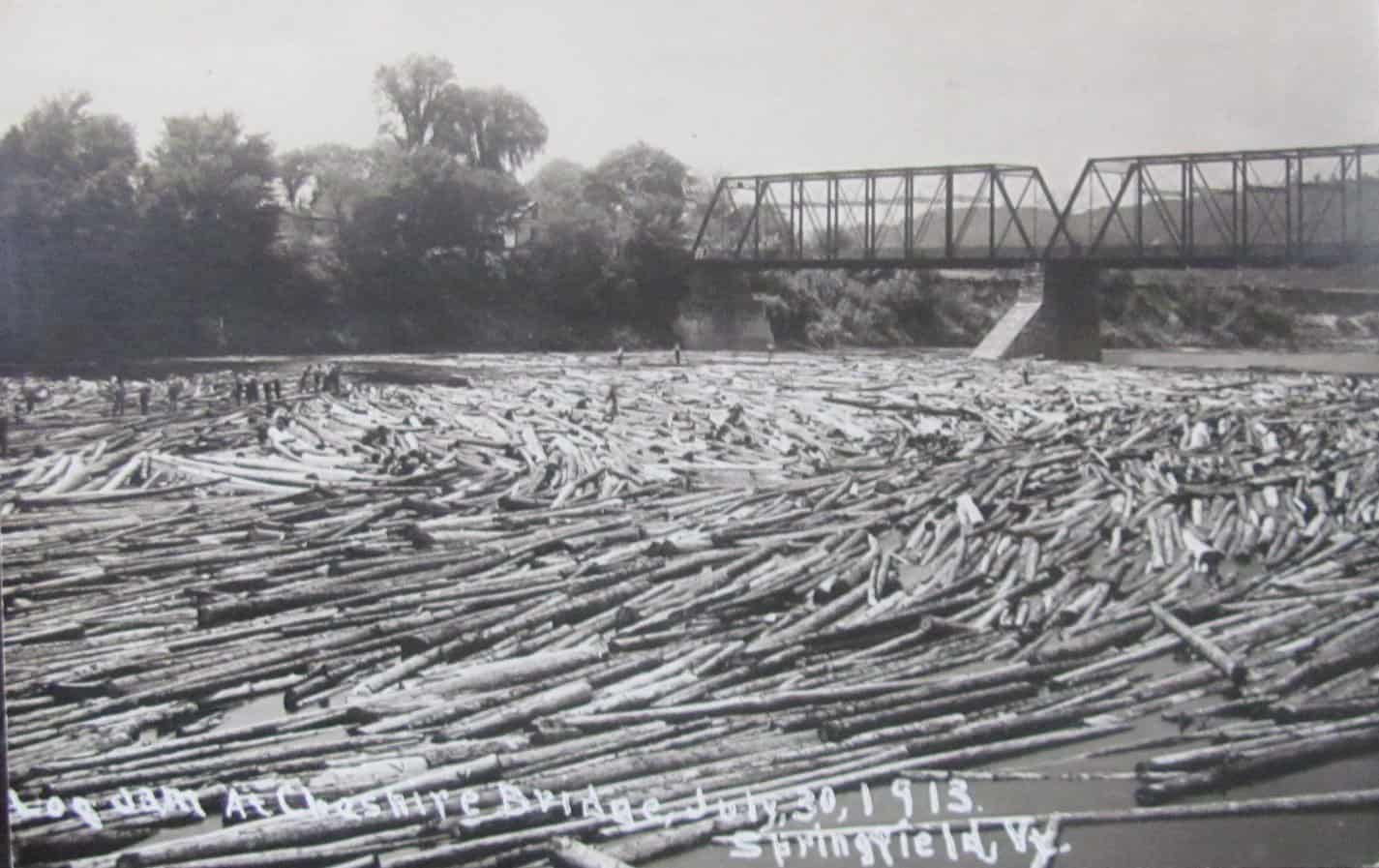
Some will know of Richard and Helen Moore at the Town Farm in Springfield. In 1998, Helen compiled a spiral bound book, “History Begins at Home.” It’s a history of Richard Moore’s family. Below is a story written by Richard’s father, Ray Moore, copied as written. The C.V.L. mentioned is the Connecticut Valley Lumber Company. I.P. is International Paper.
In part:
“I might start by saying that I was a scaler of logs and time keeper for the C.V.L. Co. and the Berlin Mills Brown Company. That is how I know so many of the old time rivermen of the Connecticut and Andriscogin Rivers. I was with the last two long log drives that went down the Connecticut River from the Connecticut Lakes to Holyoke, Mass. at Mt. Tom. I thought it might interest you folks to tell you about the last long drive of 1915, which was the longest drive in the world, 345 miles. Logs were driven from the headwaters at the Canadian border to the Long Island Sound.
The C.V.L. had 2,000 men in the woods cutting logs the winter of 1914 and 1915. The drive started in April with over 500 men on the rivers. 40 million feet from Second Connecticut Lake, 15 million feet from South Bay, First Connecticut Lake was 3 million, 3 million from Perry Stream, 6 million from Dead Water Brook, and when the drive hit North Stratford it had 65 million board feet of logs. Five men drowned at Perry Falls.
We had a big log jam at North Stratford Diamond Bridge. 35 million feet sticking up in the air 30-foot high. Flooded houses and tore up ground track of the railroad. Took a lot of work and dynamite to break the jam. Next, all of the logs had to go over Gilman Dam (at which they did not to want any water out), then Horse Race Head, and 15 Miles Falls (today the 15 Miles Falls are under a 100 feet of water). I saw Dan Besse and Simon Glisbee ride it over Mulligan Pitch at Six Island and the narrows in Woodsville opposite Wells River. Here they put the Mary Ann cook shack and horse rafts in over Wilder Dam.
We were six weeks sluicing logs in Bellows Falls that year. There were logs for over 100 miles from the rear to the head. Alphonse Roby was the big walking boss and Win Shoppe was boss of the rear. Burt Ingersoll was boss of sluicing and McDonald was General Manager. And many more foreman all famous rivermen, but Dan Besse in my book was the greatest of them all.
Also North Walpole produced some good rivermen – Joe Daigle who was in charge of the Log Yard for the I.P. Co. for years…
…The drives that I know went to Holyoke, Mass., and that drive might cover 100 miles with the cook wagon to the rear. The last camp of the drive was at Shepard Island below Hadley Bridge in 1915.
The Connecticut River was a tough drive. Falls, rapids, dams to sluice past, mill owners to fight with, dry ledges, fressets, droughts, and Ox-Bow bridges. How the rivermen hated those bridges.
Every kid in the North Country years ago wanted to go on the river drives. It was like baseball to some, but a hard life. Four o’clock in the morning until dark at night. Wet, cold, and hot. The lumberjack was a special breed, but the riverman was very special. He was a product of the environment of the Northeast. Now that environment has passed and no longer exists…
…A little about myself. I was born in Littleton, N.H., Oct. 27, 1894. My father had a clothing store in Littleton, N.H. for thirty-five years. Also, a clothing store in North Woodstock, N.H. When I was about 12 years old, my father moved from Littleton to North Woodstock. Which was some town with the summer hotels, saw mills, and hundreds of lumberjacks. There was a lot of work for boys then.
I remember the year I was twelve (1906), I went on a surveying crew, running lines for a Timber Company.
I went to Plymouth, N.H. High School, which was 21 miles from North Woodstock. I traveled on the train. During my high school days, I worked for a geological survey before the government bought the White Mountain Forest.”
I was fortunate to have met a couple of these old river men in the early 1970s.
This week’s old saying is another epitaph: “I told you I wasn’t feeling well.”